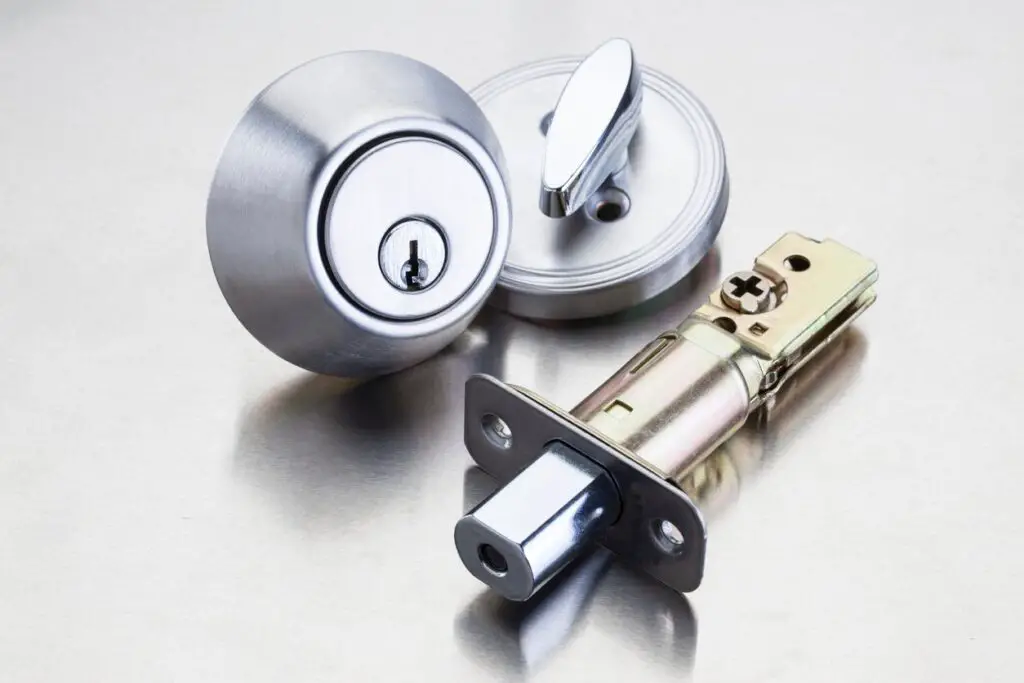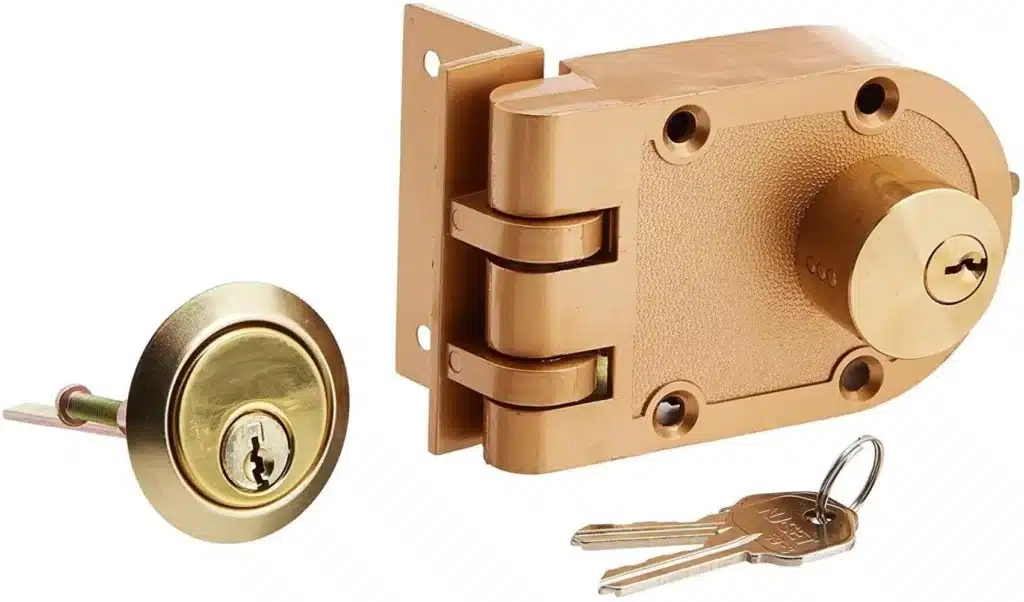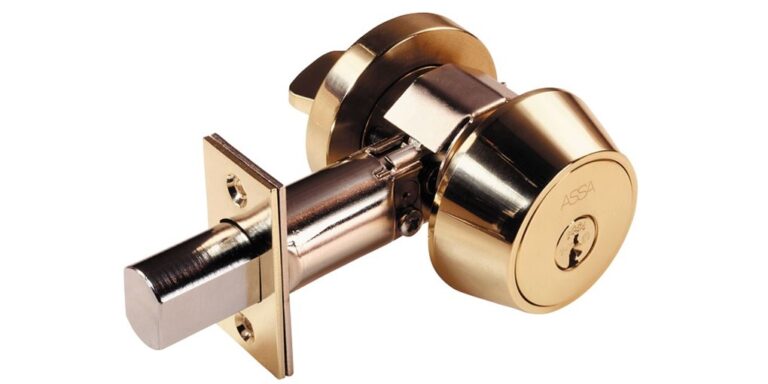Introduction
How To Unfreeze A Deadbolt Lock: Imagine a cold winter morning, and you’re running late for work or have an urgent appointment. You reach for your front door, only to find that your deadbolt lock has become frozen shut due to the frigid temperatures. It’s a frustrating situation that many of us have faced at one point or another. However, fear not! Unfreezing a deadbolt lock is a manageable task with the right techniques and a little patience.
We will explore several methods to help you thaw out that stubborn lock and regain access to your home or property during icy weather conditions. Whether you’re dealing with a traditional key-operated deadbolt or a modern electronic lock, these strategies will come in handy to get you back inside quickly and safely. In this comprehensive guide, we will explore a range of effective methods and strategies for dealing with frozen deadbolt locks, whether they are traditional key-operated models or modern electronic systems.
By the end of this guide, you will have the knowledge and tools to confidently tackle the challenge of unfreezing a deadbolt lock, ensuring your security and peace of mind even in the harshest of winter conditions. Remember that patience and caution are key when attempting to unfreeze a deadbolt lock. Rushing or using excessive force can potentially damage the lock or your property. Always prioritize safety, and consider seeking professional assistance if necessary.

Why does my deadbolt freeze?
As the weather gets colder, it can cause your locks to freeze. Frozen locks are the result of moisture accumulating by the strike or inside the lockset. The moisture could be from a recent rainstorm, snowfall, or even humidity from the warmer months that never fully dried out.
One of the primary reasons deadbolt locks freeze is the interplay between temperature and moisture. When the temperature drops below freezing, any moisture present in and around the lock mechanism can freeze. This includes not only rain, sleet, and snow but also the condensation that forms on the lock due to temperature fluctuations. When this moisture freezes, it can create ice within the lock’s keyway or internal components, causing it to become unresponsive.
Another contributing factor is the insulation of your door and lock. If your door and frame are poorly insulated, cold air can seep into your home, making it easier for the lock to freeze. Similarly, if your deadbolt has gaps or lacks proper insulation around the keyway or inside the lock mechanism, it can allow moisture to accumulate and freeze more readily.
The condition of your deadbolt lock and its maintenance play a significant role in preventing freezing. Over time, locks can become dirty or accumulate debris, making them more susceptible to freezing. Additionally, using the wrong type of lubricant or applying it improperly can cause issues when temperatures drop. Lubricants may thicken or harden in cold weather, making the lock less responsive.
Why is my deadbolt hard to turn?
One of the most common deadbolt issues is one that sticks or is difficult to turn. This is often due to a buildup of rust or grime in the components, preventing them from functioning easily. Repair your deadbolt with a dose of WD-40 (or a similar product). This will loosen dirt and rust and provide lubrication.
One of the most common reasons for a hard-to-turn deadbolt is the accumulation of dirt, dust, and debris within the lock mechanism over time. These particles can obstruct the smooth movement of the bolt, making it challenging to operate. Regular exposure to outdoor elements, such as wind, rain, and pollen, can exacerbate this issue.
Deadbolt locks, especially those exposed to moisture or humidity, can develop rust and corrosion on their internal components. Rust can significantly impede the bolt’s movement, making it hard to turn. This is a prevalent problem in coastal areas or regions with high humidity levels.
The strike plate is the metal plate installed on the door frame that the deadbolt engages with when locked. If the deadbolt and the strike plate are misaligned, it can create friction and resistance when trying to turn the lock. This misalignment can occur due to shifting of the door frame or settling of the house over time.
How do you unfreeze a lock with hand sanitizer?
The alcohol ingredients can help lower the freezing point of water, and can melt the ice inside the lock within seconds. To defrost your lock, simply coat your key with hand sanitizer and insert the key gently into the frozen lock, but do not force it. Once in place, leave for 30 seconds and let the alcohol do its job.
Safety First: Ensure you’re in a safe and well-lit environment. If you’re using any kind of de-icer, make sure to read and follow the instructions on the product label.
Prepare the Hand Sanitizer: Open the hand sanitizer container and get ready to apply it to the lock. If the sanitizer is in a squeeze bottle, it’s easier to control the amount you apply.
Apply Hand Sanitizer: Squeeze a generous amount of hand sanitizer onto your key or directly into the lock’s keyway. Be patient and let it sit for a few moments to allow the alcohol to penetrate and start melting the ice.
Insert the Key: After a brief wait, gently insert the key into the lock. The alcohol in the hand sanitizer will have begun to melt the ice, making it easier to turn the key. Be cautious not to use excessive force, as you could break the key or damage the lock.
What melts frozen locks?
The ethanol and isopropanol alcohol that destroy germs also lower the freezing point of water, and can melt the ice inside the lock within seconds. To defrost your lock, simply coat your key with hand sanitizer and insert the key gently into the frozen lock, but do not force it.
Alcohol-Based De-Icers:
Alcohol-based lock de-icers are one of the most common and effective solutions for melting frozen locks. These products typically contain isopropyl alcohol, which has a lower freezing point than water. By applying an alcohol-based de-icer to the lock’s keyway, you can quickly melt the ice and regain access.
Hand Sanitizer:
Hand sanitizer contains alcohol, usually with a high alcohol content percentage. This makes it an accessible and effective option for melting ice in locks. Simply apply a generous amount of hand sanitizer to the key or directly into the lock’s keyway, wait a moment, and then insert and turn the key.
Lock Lubricant with De-Icing Properties:
Some lock lubricants are specifically designed to not only lubricate the lock but also contain de-icing properties. These products can help prevent future freezing and make it easier to thaw a frozen lock. Apply the lubricant to the keyway and then insert and turn the key.
Can I pour warm water on frozen lock?
Gently pour lukewarm water over your car’s frozen lock or door frame. Do NOT use boiling water, as the temperature difference could shatter your car window. Be sure to dry the door off after it’s open to prevent re-freezing. Use a hairdryer and an outdoor safe extension cord to melt the ice around the door frame.
Potential for Re-Freezing: One of the main concerns when using warm water is the potential for the lock to re-freeze. As the warm water comes into contact with the cold lock, it can melt the ice temporarily. However, if the ambient temperature is still below freezing, the water may refreeze once you’re done, potentially making the situation worse.
Risk of Damage: Depending on the lock’s materials and design, pouring warm water directly onto the lock can potentially cause damage. If the lock is made of metal, sudden temperature changes from hot to cold can cause it to contract, leading to potential warping or other issues.
Frozen Mechanisms: In some cases, the lock’s internal mechanisms may also freeze, making it challenging to turn even after the ice in the keyway has melted. Pouring warm water may not address this underlying issue.
How do you loosen a stuck deadbolt?
Sometimes the lock is stuck because the parts inside it have disengaged. Take a small hammer to the body surrounding the keyhole. Twist the key back and forth as you tap on the lock with your hammer. This might take a while as it’ll take the parts time to fall back into place and work to open the lock.
Assess the Situation:
Before attempting to fix a stuck deadbolt, take a moment to assess the situation. Determine whether the lock is stuck in the locked or unlocked position. This information will guide your troubleshooting efforts.
Lubrication:
Often, a stuck deadbolt is the result of inadequate lubrication. Begin by applying a lubricant designed for locks into the keyhole and along the bolt’s edges. Let it sit for a few minutes to penetrate and loosen any debris or rust. Then, insert your key and gently attempt to turn the deadbolt.
Use the Correct Key:
Ensure you are using the correct key for the lock. Using a worn or damaged key can exacerbate the problem. If the key is bent or shows signs of wear, consider getting a new key made.
Why won’t my deadbolt lock move?
Fortunately, this is often an easy fix. Simply grab a can of WD-40, silicon-based lubricant, graphite spray, or a dry lubricant and spray it into the keyway. Once it has been sprayed, insert the key so the lubricant will work into the locking mechanism.
One of the most frequent reasons for a deadbolt lock not moving is the accumulation of dirt, dust, and debris within the lock’s mechanism. These particles can obstruct the smooth operation of the bolt, causing it to stick.
Solution: Begin by applying a lubricant designed for locks into the keyhole and along the bolt’s edges. Let it sit for a few minutes to help loosen any debris. Then, insert your key and attempt to turn the deadbolt while applying gentle, steady pressure.
Misalignment between the deadbolt and the strike plate on the door frame is another common issue. If the deadbolt and the strike plate do not align correctly, it can cause the deadbolt to become stuck.
Solution: Inspect the deadbolt and the strike plate for any signs of misalignment. Adjust the strike plate as needed to ensure proper alignment. This may involve repositioning or reinstalling the plate.
Deadbolt locks exposed to moisture or humidity can develop rust and corrosion on their internal components. Rust can significantly impede the bolt’s movement.
Solution: Apply a rust and corrosion penetrant or a lock lubricant with de-icing properties into the keyhole and around the bolt. Allow it to sit for a few minutes to help break down the rust. Then, attempt to turn the deadbolt.
How do you defrost a house door lock?
Heating your key, carefully, with the cigarette lighter from your car (or a normal lighter, if you carry one), is a good option. Another thing that you can try is spraying some WD-40 onto the lock to loosen things up. If you do this, be patient and let it work.
De-icer spray: A commercial lock de-icer spray is specifically designed to melt ice and is readily available at most hardware stores.
Isopropyl alcohol: A high-percentage isopropyl alcohol (70% or higher) can be used as an alternative to de-icer spray.
Warm water: If you don’t have de-icer or isopropyl alcohol, warm water can be used effectively.
Hairdryer or heat gun: A hairdryer or heat gun can provide a controlled source of heat to thaw the lock.
Graphite lubricant: After thawing the lock, consider applying graphite lubricant to prevent future freezing.

Conclusion
Facing a frozen deadbolt lock can be a real challenge, especially when you need to get in or out of your home or property in adverse weather conditions. Whether it’s a result of freezing temperatures, icy rain, or even a malfunctioning lock mechanism, dealing with a frozen deadbolt is a situation that requires quick and effective solutions. Fortunately, with the right knowledge and a few door lock simple tools, you can thaw out that stubborn lock and regain access without resorting to drastic measures.
By following the guidance provided in this guide, you can confidently address the challenge of a frozen deadbolt lock, ensuring you maintain the security and convenience of accessing your home or property, regardless of the weather conditions. With these tools and techniques in your repertoire, you can face the cold with confidence and ensure that your lock woes won’t keep you out in the cold for long.
Remember to approach the situation with patience, as forcing the lock can lead to further complications. Choose the method that suits your circumstances best, and always prioritize safety when attempting to unfreeze a deadbolt lock. If you find yourself unable to resolve the issue or are concerned about damaging the lock, don’t hesitate to seek professional locksmith assistance.

